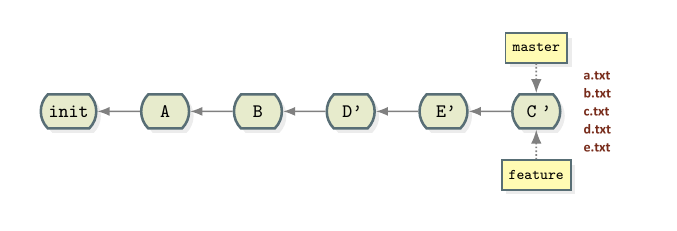
- #GIT REBASE ON ANOTHER BRANCH UPDATE#
- #GIT REBASE ON ANOTHER BRANCH UPGRADE#
- #GIT REBASE ON ANOTHER BRANCH CODE#
The second real-life is during the review/approval phase. Which results in A(main) < goes-before-B < B(first) < C(second-requires-first) < D(third-requires-second) With Git v2.38, my solution is git rebase -interactive -update-refs first~ Maybe git-log or a Git graph UI to figure what B' and C' are relative to third-requires-second, or to look up their IDs, and then some git reset -hards or git branch -fs. Git surgery is required to point first to B' and to point second-requires-first to C'. Which would result in A(main) < goes-before-B' < B' < C' < D'(third-requires-second) I'm at A(main) < B(first) < C(second-requires-first) < D < goes-before-B(third-requires-second)Īnd want to be to A(main) < goes-before-B < B(first) < C(second-requires-first) < D(third-requires-second)īefore Git v2.38 my solution was # Step 1. I'm working at third-requires-second and make a change that belongs in first.

(I'm keeping each branch to only one commit for legibility.) A(main) < B(first) < C(second-requires-first) < D(third-requires-second)
#GIT REBASE ON ANOTHER BRANCH CODE#
Maybe they are for dependent features maybe it's one large feature, and I'm splitting it up to make code review more feasible. I sometimes build several branches upon each other. The first real-life scenario is during development. I'm excited about this enhancement because of two scenarios I run into: Here's the difference: A < B(main)įollowed by git rebase -update-refs main feature
#GIT REBASE ON ANOTHER BRANCH UPDATE#
With -update-refs, git-rebase will also update all branches which start out pointing to commits that then get rebased. Results in A < B(main) < C' < D'(feature) Here's what happens in a multi-branch situation with a standard rebase: A < B(main) But what if there are intermediate branches between the specified branch's fork point ( A in the above example) and the branch you're rebasing? The new capability # or the convenient form git rebase main feature- results in A < B(main) < C < D(feature) Rebasing C off B - for example with git checkout feature
#GIT REBASE ON ANOTHER BRANCH UPGRADE#
To get the latest, you can use Homebrew: even if you haven't installed Git with Homebrew before, you can run brew upgrade git.Ī standard rebase results in up to one branch pointing at a different commit than it did before A < B(main) To see your Git version, run git -version.

With -update-refs, rebasing will "Automatically force-update any branches that point to commits that are being rebased" ( docs). When you’re done fixing a conflict, simply git add the file and continue rebasing:Īlternatively, pull with rebase to prevent having to switch out of the current branch.In version Git v2.38 (released Oct 3 2022), git-rebase learned a new -update-refs option. To restore the original branch and stop rebasing run "git rebase -abort". If you would prefer to skip this patch, instead run "git rebase -skip". When you have resolved this problem run "git rebase -continue". Using index info to reconstruct a base tree.įalling back to patching base and 3-way merge.ĬONFLICT (content): Merge conflict in config/environment.rb Unlike a merge, which merges two branches in one go, rebasing applies the changes from one branch one by one.īecause of that, conflicts will be served in smaller chunks making them easier to fix and understand:

It’s as if you didn’t start working in the login branch before the commits you pulled in were made 1. This bases the current branch onto the other branch.įirst, rewinding head to replay your work on top of it. Git’s rebase command temporarily rewinds the commits on your current branch, pulls in the commits from the other branch and reapplies the rewinded commits back on top. Instead of merging the main branch in, rebasing it rewrites history to make sure all commits on the login branch are based on the current state of the main branch.įigure 3: Rebasing applies the commits from the login branch on top of the main branch. In this case, it’s not important to know when main was merged in, and there is nobody else working on the login branch. When working on a branch with multiple people, merging is preferable to rebasing as it leaves the branch history intact.įigure 2: Merging the two branches results in a merge commit. Merging a branch is useful when the moment of merging is significant.įor example, when a feature is merged into the main branch, or when a new release is pushed. Merging the main branch back into yours would result in a merge commit, which includes the changes between both branches and exists to show where a merge occurred.


 0 kommentar(er)
0 kommentar(er)
